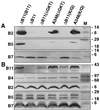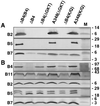Role of Agrobacterium VirB11 ATPase in T-pilus assembly and substrate selection
- PMID: 11566978
- PMCID: PMC99657
- DOI: 10.1128/JB.183.20.5813-5825.2001
Role of Agrobacterium VirB11 ATPase in T-pilus assembly and substrate selection
Abstract
The VirB11 ATPase is a subunit of the Agrobacterium tumefaciens transfer DNA (T-DNA) transfer system, a type IV secretion pathway required for delivery of T-DNA and effector proteins to plant cells during infection. In this study, we examined the effects of virB11 mutations on VirB protein accumulation, T-pilus production, and substrate translocation. Strains synthesizing VirB11 derivatives with mutations in the nucleoside triphosphate binding site (Walker A motif) accumulated wild-type levels of VirB proteins but failed to produce the T-pilus or export substrates at detectable levels, establishing the importance of nucleoside triphosphate binding or hydrolysis for T-pilus biogenesis. Similar findings were obtained for VirB4, a second ATPase of this transfer system. Analyses of strains expressing virB11 dominant alleles in general showed that T-pilus production is correlated with substrate translocation. Notably, strains expressing dominant alleles previously designated class II (dominant and nonfunctional) neither transferred T-DNA nor elaborated detectable levels of the T-pilus. By contrast, strains expressing most dominant alleles designated class III (dominant and functional) efficiently translocated T-DNA and synthesized abundant levels of T pilus. We did, however, identify four types of virB11 mutations or strain genotypes that selectively disrupted substrate translocation or T-pilus production: (i) virB11/virB11* merodiploid strains expressing all class II and III dominant alleles were strongly suppressed for T-DNA translocation but efficiently mobilized an IncQ plasmid to agrobacterial recipients and also elaborated abundant levels of T pilus; (ii) strains synthesizing two class III mutant proteins, VirB11, V258G and VirB11.I265T, efficiently transferred both DNA substrates but produced low and undetectable levels of T pilus, respectively; (iii) a strain synthesizing the class II mutant protein VirB11.I103T/M301L efficiently exported VirE2 but produced undetectable levels of T pilus; (iv) strains synthesizing three VirB11 derivatives with a four-residue (HMVD) insertion (L75.i4, C168.i4, and L302.i4) neither transferred T-DNA nor produced detectable levels of T pilus but efficiently transferred VirE2 to plants and the IncQ plasmid to agrobacterial recipient cells. Together, our findings support a model in which the VirB11 ATPase contributes at two levels to type IV secretion, T-pilus morphogenesis, and substrate selection. Furthermore, the contributions of VirB11 to machine assembly and substrate transfer can be uncoupled by mutagenesis.
Figures







Similar articles
-
Dimerization of the Agrobacterium tumefaciens VirB4 ATPase and the effect of ATP-binding cassette mutations on the assembly and function of the T-DNA transporter.Mol Microbiol. 1999 Jun;32(6):1239-53. doi: 10.1046/j.1365-2958.1999.01436.x. Mol Microbiol. 1999. PMID: 10383764 Free PMC article.
-
Agrobacterium tumefaciens VirB9, an outer-membrane-associated component of a type IV secretion system, regulates substrate selection and T-pilus biogenesis.J Bacteriol. 2005 May;187(10):3486-95. doi: 10.1128/JB.187.10.3486-3495.2005. J Bacteriol. 2005. PMID: 15866936 Free PMC article.
-
Suppression of mutant phenotypes of the Agrobacterium tumefaciens VirB11 ATPase by overproduction of VirB proteins.J Bacteriol. 1997 Sep;179(18):5835-42. doi: 10.1128/jb.179.18.5835-5842.1997. J Bacteriol. 1997. PMID: 9294442 Free PMC article.
-
Promiscuous DNA transfer system of Agrobacterium tumefaciens: role of the virB operon in sex pilus assembly and synthesis.Mol Microbiol. 1994 Apr;12(1):17-22. doi: 10.1111/j.1365-2958.1994.tb00990.x. Mol Microbiol. 1994. PMID: 7914664 Review.
-
The role of the T-pilus in horizontal gene transfer and tumorigenesis.Curr Opin Microbiol. 2000 Dec;3(6):643-8. doi: 10.1016/s1369-5274(00)00154-5. Curr Opin Microbiol. 2000. PMID: 11121787 Review.
Cited by
-
Two pKM101-encoded proteins, the pilus-tip protein TraC and Pep, assemble on the Escherichia coli cell surface as adhesins required for efficient conjugative DNA transfer.Mol Microbiol. 2019 Jan;111(1):96-117. doi: 10.1111/mmi.14141. Epub 2018 Oct 21. Mol Microbiol. 2019. PMID: 30264928 Free PMC article.
-
Unveiling molecular scaffolds of the type IV secretion system.J Bacteriol. 2004 Apr;186(7):1919-26. doi: 10.1128/JB.186.7.1919-1926.2004. J Bacteriol. 2004. PMID: 15028675 Free PMC article. Review. No abstract available.
-
Arabidopsis RETICULON-LIKE4 (RTNLB4) Protein Participates in Agrobacterium Infection and VirB2 Peptide-Induced Plant Defense Response.Int J Mol Sci. 2020 Mar 3;21(5):1722. doi: 10.3390/ijms21051722. Int J Mol Sci. 2020. PMID: 32138311 Free PMC article.
-
Chimeric Coupling Proteins Mediate Transfer of Heterologous Type IV Effectors through the Escherichia coli pKM101-Encoded Conjugation Machine.J Bacteriol. 2016 Sep 9;198(19):2701-18. doi: 10.1128/JB.00378-16. Print 2016 Oct 1. J Bacteriol. 2016. PMID: 27432829 Free PMC article.
-
Agrobacterium VirB10 domain requirements for type IV secretion and T pilus biogenesis.Mol Microbiol. 2009 Feb;71(3):779-94. doi: 10.1111/j.1365-2958.2008.06565.x. Epub 2008 Dec 1. Mol Microbiol. 2009. PMID: 19054325 Free PMC article.
References
-
- Beijersbergen A, Smith S J, Hooykas P J J. Localization and topology of VirB proteins of Agrobacterium tumefaciens. Plasmid. 1994;32:212–218. - PubMed
Publication types
MeSH terms
Substances
Grants and funding
LinkOut - more resources
Full Text Sources

